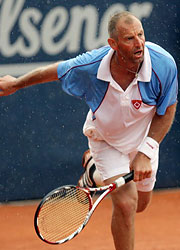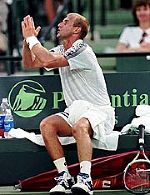Thomas Muster Is On The Comeback Trail

More than a decade after last playing on tour, Thomas Muster is back playing with the top players in the world.
Thomas Muster first attracted attention for his strokes. Ivan Lendl, who defeated the then-21-year-old in the semis of the Australian Open in 1989, said the Austrian had one of the hardest forehands on tour.
Those strokes had made him the first Austrian to go that deep in a major or reach the top 10, and he looked likely to keep ascending: Just a couple of months later, he backed up his Australian run by reaching the finals of the Lipton Championships in Key Biscayne, where he was set for another encounter with Lendl.
It was not to be, as Muster was hit by a drunk driver just hours after winning in the semis, leaving him with a severely injured knee. This setback, though, only served to reveal a bigger weapon than his forehand: his determination.
The Austrian became one of the stories of the men’s tour that year as he was videotaped on the courts sitting in a specially designed chair that allowed him to practice hitting as his injury continued to heal. Then, just six months after the accident, he was not only recovered but back on tour, and would win Adelaide, the first event he played in 1990.
Muster would forever be associated with this comeback, and it would be repeatedly cited by those who could think of little else that was nice to say to about him.
For Muster, though he deserves mention alongside Jimmy Connors and Lleyton Hewitt as one of the game’s great competitors, shared with those two a reputation for prickly behavior on court and solitary activity off of it. At various times in his career he earned the ire of some of the game’s greats, including Pete Sampras and Andre Agassi. Brad Gilbert notably said once that, due to a mid-match stare-down from the Austrian, Muster was the only guy that Gilbert had ever “wanted a piece of” after the match.
But that combativeness was at least somewhat beneficial: It helped him stretch every inch of his natural gifts. Despite the loss of momentum dealt by his knee injury, Muster had a reputation for clay court savvy early on. He lacked Connors’ revolutionary ability to hit early and crush returns, and was not the pure athlete that Hewitt could claim to be, but he had still won 22 clay court titles going into the 1995 season.
And then his results on the surface simply exploded: By ’95, thanks to the pioneering play of Lendl, Andre Agassi, and Jim Courier, big forehands were no longer rare, but Muster had supplanted Lendl and Courier as the game’s fittest player. With almost no limits to his endurance (he’s said to have once run a marathon’s distance by accident when he took a wrong turn while jogging) and the mindset of a prizefighter, Muster made every point on clay a distance run.
Much like with Bjorn Borg in the late-‘70s, he simply ran down everything an opponent hit at him from the backcourt and ripped passes by them if they came to net. In that year alone, he won 11 clay court titles, including the Roland Garros crown, where he simply destroyed several well-known clay court players, including Andrei Medvedev, Yevgeny Kafelnikov, and Michael Chang.
As his confidence grew, he also had some success in translating those results onto harder surfaces that year, including in the indoor courts of Essen, where he beat Sampras along the way.
When he reached the No. 1 ranking in the following spring, though, his forays on the hard courts had done little to insulate him from the charge that he was one-dimensional, and had run up the score on his favorite surface to place him ahead of Sampras and Agassi, his more well-rounded rivals.
And though Muster had proven that he could win on the asphalt by this point, he remains the only Grand Slam champion and world No. 1 to have never won a match at Wimbledon (he didn’t even bother playing there after 1994). The criticism from his peers and from the media further motivated the Austrian, though, as he sought to burnish his credentials on other surfaces.
In 1997 he reached the semis of the AO for the second time before falling to Sampras. Then he won in Dubai that February.
And then, in a poetic turn, he made his way back to the Lipton that March, finally winning the event where he had been denied the right to even contest the final seven years prior. This win was all-the-more profound in that it would be his last.
He was 30 at that point, and had done well to extend his winning ways that long, but his clay court season in 1997 was disastrous, as he won no titles on the surface and exited in the first or second round seven times. He reached one more tour final in 1998, but following his first round exit from Roland Garros in 1999 he never played on the ATP Tour again.
Until this year, that is. When I first heard that Muster, now literally double the age he was when he reached his first Slam semi, was accepting wild cards and returning to top flight competition, I thought it was a joke. Muster had not played a pro match in 11 years, won a title in 13, and had not exactly been dominant on the seniors’ tour in the previous decade.
But Muster has in fact returned and played twice this summer, getting manhandled by 145th-ranked Irishman Conor Niland in Braunschweig, Germany, in June and dropping a closer match to No. 99 Dustin Brown in Kitzbuhel, Austria early this month. He’s had very little to say about what has motivated him, but that’s nothing unusual for Muster, who never officially retired.
“At the time all I said was I was going on holiday,” he said in June, “so now I’m back from my holiday.”
We can’t know how successful he’ll be, or how long he’ll keep it up if it proves unsuccessful. We don’t even really know why he’s doing it yet, but I suspect he sees it as just the latest challenge.
Just like his knee injury, winning in Paris, getting to No. 1, and winning the Lipton. I don’t know what motivates him to keep trying for these goals, but it’s a quality I wish more players had.

And way more Elite Weed Grower essentials
When I open up your Feed it appears to be a ton of garbage, is the problem on my part?
Wow, wonderful blog format! How lengthy have you ever been blogging for?
you made blogging glance easy. The entire look of your web site
is magnificent, let alone the content!
Yes, some of us break the traffic laws occasionally, but if we mess up, we die
parcel courier in Adelaide